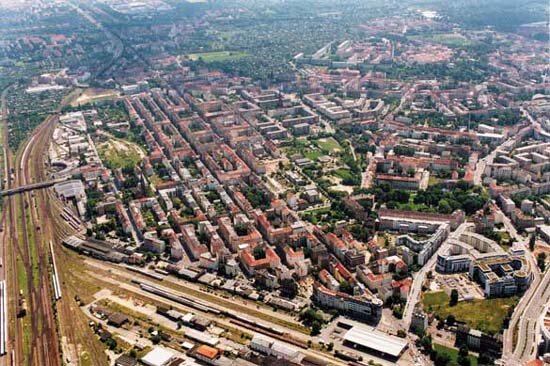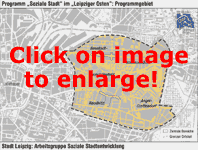soziale stadt - bundestransferstelle
besonderem Entwicklungsbedarf - Soziale Stadt"
Leipzig East Leipzig
|
Christa Böhme
The district was developed in the mid-19th century, and rapidly became a dense, highly mixed residential and working neighbourhood. The area was known as the "graphic quarter" because commerce and industry was dominated by publishing companies and printing works. Residents were mostly workers, so that the "Red East" of Leipzig always enjoyed the negative reputation of a classical working class district.
During the Second World War, the area suffered considerable destruction, and the graphic industry never really recovered. During the period of the GDR, there were few resources available for reconstruction and maintenance. Since the end of the 1970s, inner-city pre-fabricated substitute housing was built, some nineteenth century housing stock was modernised, and new green areas were established in formerly heavily built-up neighbourhoods. After the demise of the GDR, the official designation of some urban renewal areas in parts of the model area initiated a far-reaching process of regeneration, which, however, has waned considerably since the end of the 1990s owing to worsening (fiscal) conditions and declining demand for rehabilitated housing. East Leipzig, which is structurally weak anyway, has lost out to other, more attractive districts. Social, economic, ecological, and urban planning problems are concentrated in the present "district with special development needs." 2. Main Problems and Development Potential
|
||||||||||||||||||||||||||||||||||||||||||||||||||||||||||||||||||||||||
|
The main problems facing East Leipzig are due to the shrinkage of Leipzig since the change in regime owing to a strong decline in the birth rate, substantial outmigration to the "old federal states," and "catch-up" suburbanisation processes. The consequent easing of the housing market and attractive rents throughout the city have made it easy for people to move house, engendering considerable segregation processes. Better-off "middle-class families" are moving to more attractive districts from the more disadvantaged parts of East Leipzig, in particular, while poorer households are moving in. The vacancy rate in both rehabilitated and unrehabilitated housing is about 40%, in some areas even higher. |
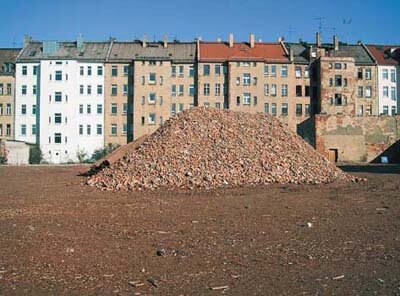 |
Derelict land, modernisation and rehabilitation deficiencies (Source: Büro Kaufmann, Leipzig) |
The demographic structure of the district population is characterised partly by overageing and overall by a high proportion of children and adolescents. Among less well-off new arrivals are a comparatively large number of migrant households and ethnic German immigrants from eastern Europe; the proportion of migrants in parts of East Leipzig is greater than the average for the city as a whole. Owing to segregation and social disintegration, the present social structure of East Leipzig - especially Volksmarsdorf - generates serious problems. The proportion of single parents and recipients of transfer payments is higher the Leipzig average. The same is true for juvenile delinquents and hard-drug users.
In East Leipzig the unemployment rate is also higher than the citywide average and is continuing to rise. Few training positions or jobs are available in the model area. As a result of declining purchasing power, local economic structures, notable the retail trade and craft businesses, are eroding. Closures and vacant business premises are the visible sign of economic decline.
East Leipzig consists largely of neighbourhoods with a high plot ratio and degree of soil surface sealing and without adequate green spaces. There is a disproportionate amount of derelict land - partly with ruined buildings. The residential environment in many parts is no longer up to current standards. The appearance of public spaces is not very appealing, especially in parts of Volksmarsdorf.
Various facilities, self-help groups, clubs, organisations, and action groups, along with churches and day-care nurseries constitute the social infrastructure of East Leipzig. But the range of facilities and services is declining because costs have to be cut or the demand is falling. This is also the case with the educational infrastructure. Because the population is falling, schools are being closed throughout Leipzig, including the last grammar school (Gymnasium) located in the model area. Finally, the almost complete lack or continuing decline of the cultural infrastructure, including the pub and culture scene, is regarded as one of the main reasons for the comparative unattractiveness of the model area.
Community life in East Leipzig is rendered difficult by the urban planning and social problems mentioned and, to some extent, by the prejudices of the German population against migrants. Various indicators point to a lack of family cohesion in many households owing to unemployment, alcoholism, and the high number of single parents.
Demography and Social Space
|
East Leipzig |
Leipzig |
|
|
Size |
340 ha |
29 754 ha |
|
Population |
approx. 27 000 |
approx. 493 000 |
|
Population decline (1990–2000) |
approx. 30 % |
approx. 15 % |
|
Average household size |
n.a. |
1.9 pers. |
|
Number of dwellings |
24 500 (1) |
approx. 315 000 |
|
Vacancy rate |
40 % (1) |
20 % |
|
Housing benefit recipients |
approx. 14% |
approx. 10 % |
|
Unemployment rate |
n.a. |
18.1% |
|
Social assistance recipients |
n.a. |
n.a. |
|
Foreign population |
7.2 % (1) |
5.5 % |
|
Population under 18 |
approx. 17 % |
14.6 % |
|
Population 65 and older |
approx. 14.5 % |
18.6 % |
|
(1) Without Reudnitz-Thonberg |
||
In general, it is difficult to identify development potential for the whole of East Leipzig because of the size and diversity of the model area. The search for "genuine" development potential is made more difficult by the decline in the number of residents and the strongly entrenched negative image of the area. Nonetheless, certain possibilities for development can be discerned:
The potential of the area structure: apart from "deprived areas," the model area also has relatively intact "islands" which could have a positive impact on adjacent areas if appropriately promoted.
Urban planning potential: East Leipzig is close to the centre of town with direct public transport to the central railway station and good public transport and motorway access. The compact development structures offer further potential. Derelict and gap sites and empty buildings can be appropriated to new uses, and partial demolition and redevelopment can remedy the lack of green spaces, thus improving the quality of life in the district. Derelict land is also suitable for the construction of inner-city single-family houses and row houses; vacant buildings can be used for large-surface "scene uses" such as loft apartments and studios. Despite competition from the inner city, the large supply of inexpensive housing in East Leipzig can be regarded as offering potential for accommodating younger sections of the population like students and artists as "pioneers" in economic regeneration. Many dwellings are also suitable for use in self-organised youth work.
Potential in the field of the local economy: retailers, under considerable pressure to take action, have established an association to defend their interests, and are extremely willing to collaborate in implementing measures and projects. Demolition, rehabilitation, modernisation, and improvement of the residential environment can be coupled with training and job creation measures, which at the same time benefit disadvantaged population groups and local craft and building firms.
Potential in the field of civic engagement/community work/social infrastructure. Residents themselves - especially children and adolescents - are an important resource "per se." In spite of problematic developments in the model area, it can be said that the population identifies strongly with East Leipzig. Organisations and institutions already present in the district must be considered as potentials for social engagement and resident organisation/participation.
The potential offered by the "Socially Integrative City" programme: the organisational structures and improved financial possibilities provided through the programme open up new scope for action in urban development.
Many actors emphasise the social problems in the model area, while urban planning aspects tend to be named as offering potential for development. In East Leipzig it will therefore also be essential to take account of "covert" social resources in and through the possibilities of urban development in integrated district renewal projects and measures.
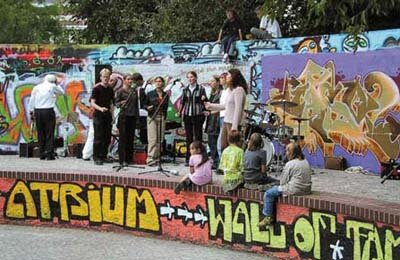 |
Children and young people show commitment for their district (Source: Büro Kaufmann, Leipzig) |
3. Development Goals and Focal Points of Action 
In late 1999, in the context of applying for inclusion in the "Socially Integrative City" programme, the Plan of Action "Integrative District Development in East Leipzig" was drawn up on the basis of the citywide "Urban Development Plan for Housing and Urban Renewal" (STEP W+S) by the interdepartmental municipal working group "Socially Integrative City." In early 2000 the Leipzig city council took cognisance of this plan.
To avoid anticipating the desired public discussion of the issue, the plan does not provide a conclusive description of development goals for East Leipzig. However, certain goals have been tentatively addressed as a basis for broader discussion. They include the following:
- to overcome the negative image;
- to strengthen local identity and enhance self-reliance and participation in the district;
- to stabilise the social structure, to develop neighbourhood social networks;
- to improve the social infrastructure;
- to improve residential quality, especially dwelling environs;
- to increase the design quality of public spaces;
- to revitalise the local economy with the aim of promoting employment and business start-ups.
No focal areas of action have yet been defined below the goal level. The further specification of goals is to be the task primarily of the East Leipzig Forum. The plan of action as a whole has not yet been updated. In implementing the STEP W+S, preparatory studies in accordance with urban renewal law are been carried out to prepare and coordinate integrated measures for improving the quality of life in the district, and a "Conceptual District Plan" for East Leipzig is being drawn up, summarising development objectives for the model area. A cooperative advisory procedure has been carried out in preparing the plan, involving experts from the fields of architecture, urban and landscape planning, the housing industry, as well as the citizenry. The "Conceptual District Plan" is also been drawn up in close collaboration with the East Leipzig Forum.
4. Key Projects 
East Leipzig is one of the largest "Socially Integrative City" programme areas in the country. The resulting difficulty in identifying suitable spatial units for implementation control and action has been solved by defining comparatively compact "core zones." Projects and measures carried out in these zones are intended to have an impact on adjacent portions of the model area.
To date, the "Socially Integrative City" project landscape has been characterised primarily by complex "core projects" comprising a range of individual measures. They were selected by the municipality before the start of programme implementation to give initial impetus in the "core zone" and to remedy the most serious deficiencies in the district. Once implementation had got under way, project development was increasingly shifted from the municipality into the model area.
The following projects, mostly falling in the "local economy" field are to be regarded as key projects in integrated district development in East Leipzig.
The core project "Local Employment Development" aims to integrate socially disadvantaged people in the model area in the primary labour market by means of employment promotion projects adapted to local conditions. Locally based forms of placement are used in collaboration with the Social Services Office and the Employment Office, taking account of the socio-cultural particularities of the area and its residents. Accompanying this measure, a concept is being developed in cooperation with the Office for Economic Development, which aims to improve the general setting for entrepreneurial activities as the basis for creating new jobs.
One example of a measure under this core project is the implementation of the job creation project "Qualification and Work not Social Assistance (Chemnitz Model)." After a three-month preparatory period supervised by the Educational Organisation of Saxon Industry (bsw), 24 social-assistance recipients were given limited, government subsidised employment contracts with local firms. In addition, the bsw conducted a survey of 100 firms in the model area to identify local industry's problems and resources (as relevant for the labour market), which were to be taken into consideration in planning further measures.
Since the spring of 2001, a "work coordinator" has been coordinating and networking all employment projects in the model area, the aim being to bundle resources for the entire field of job promotion. The coordinator's specific tasks include keeping account of all current employment projects and those responsible, providing a complete overview of primary and secondary labour market employment promotion possibilities, preparing recommendations on the optimum coordination/bundling of financial resources available for job promotion, and maintaining intensive contact with the district management, public authority circle and project team meeting. In addition, he develops recommendations in the employment field for the specific project landscape of East Leipzig, and works closely together with the core project "Local Employment Development."
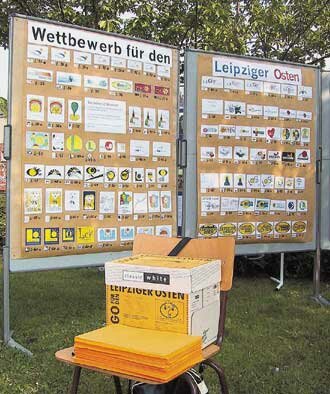 |
Logo and slogan competition (Source: Büro Kaufmann, Leipzig) |
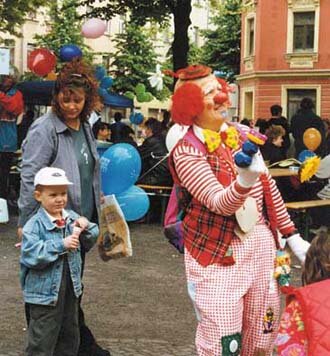 |
District festival in East Leipzig (Source: Leipzig Municipality/Rother) |
The core project "Eisenbahnstraße Centre Development" is being developed and carried out by the chamber of industry and commerce in the framework of shopping street management. The aims are to upgrade the traditional shopping street into a multi-functional identification and communication area, to concentrate industrial and commercial uses, to establish efficient enterprise dimensions, to improve the attractiveness of street space, and to reorganise public parking. Specific implementation strategies include setting up project-specific discussion platforms and working parties, providing support for the Eisenbahnstraße business people's association, establishing advertising and interest associations, further developing and implementing existing revitalisation concepts, promoting a targeted business establishment policy, and providing free-of-charge training courses for local business people.
The core project "Community-Oriented Projects" aims to provide documentation of recreational and cultural amenities and community-oriented projects in the model area as a basis for developing further projects or for supporting local actors in elaborating and implementing such concepts. Local actors are to be organised, coordinated, and supported in action and interest groups in developing community-oriented projects. Such projects include the Neustädter Markt district festival. Among other projects planned are the establishment of a "culture mile" in the model area. Partners in this project are the municipal Department of Culture and the Urban Development and Building Department.
In summer 2001 a competition was staged to find a logo and slogan to be used free of charge by all local and locally committed actors to foster identification with the model area. After a preliminary decision on the best designs submitted by residents, a meeting of the East Leipzig Forum in November 2001 awarded prizes for the best logo and the best slogan ("The Sun Rises in the East").
5. Organisation and Management 
The Saxony government distinguishes between district and neighbourhood management, the former dealing with project and process control at the supralocal level, while the latter operates directly on the spot, being responsible for, among other things, resident activation. Following this distinction, the Leipzig municipality has set up management and organisational forms for programme implementation in the model area.
Administrative level
So far, the steering group "New Founders' Age" has provided for fundamental inter-departmental coordination at the control level. An Advisory Council for Integrative District Development is currently being established, to be chaired by the assistant for urban development and building and composed of representatives from politics, clubs and associations, the administrative authorities, and the employment office, with the task of developing recommendations for implementation of the programmes "Socially Integrative City," URBAN, and "Urban Development" (EFRE) in all Leipzig programme areas.
The Office for Urban Renewal and Housing Construction Promotion and the district management head and moderate the interdepartmental Working Group "Socially Integrative City" ("public authority circle"), in which the activities of the public authorities involved in programme implementation in East Leipzig are discussed and coordinated at the competent chief officer/officer level. This body also develops and discusses new projects and their financing, coordinates support, and bundles public resources. The working group reports regularly to the mayor's office.
The district management is staffed by an employee from the Office for Urban Renewal and Housing Construction Promotion in the quasi-capacity of a district agent and an external employee from a private planning firm as managing director of the "East Leipzig Forum." The district management manages implementation of the "Socially Integrative City" programme in the model area. Its main tasks are the control, organisation, and further development of the entire process, the elaboration and updating of the integrated action plan, the acquisition and bundling of financial support, and public relations. It has to mediate between individual projects (for example, by arranging "project team meetings"), identify needs through contact with residents, and encourage as broad a public as possible to participate in the process of district development.
Intermediary area
One key task of the district management is to prepare, stage, and document the "East Leipzig Forum," a participatory and cooperative body where development goals are discussed and appropriate recommendations developed for submission to the political and administrative authorities and the public. It operates as a discussion platform in the sense of a "district assembly" for the broad spectrum of local actors. Its main functions are to offer a permanent and open communication process between local actors, the exchange of information on developments, activities, and projects in East Leipzig, the coordination of various activities and local actors, and the development of new project ideas.
 |
Model Area "East Leipzig" in the "Socially Integrative City" Programme |
It meets at quarterly intervals in the model area, and its decisions are advisory in nature. It has particular weight in the context of district development planning because in connection with the elaboration of the integrated action plan it has the job of determining the main focus of future work in East Leipzig. Issue-specific working groups have formed in the context of forum meetings, which have now assumed decisive competence for the development of new projects.
Local implementation level
The Volksmarsdorf neighbourhood management in the suburb of that name is operated by the Office for Urban Renewal and Housing Construction Promotion. Its office "Citzens' Centre") is provided rent-free by the Leipziger Wohnungs- und Baugesellschaft mbH (LWB). It has a staff of five responsible for different areas of activity, and in 2001 four job-creation scheme positions provided assistance. The financing of the neighbourhood management - leaving aside the job-creation scheme positions - corresponds to just under two full-time jobs.
To start with, the Volksmarsdorf neighbourhood management could not rely on existing civic organisations and action groups; the area had very few community structures. The main task was therefore to establish contacts in the neighbourhood and to set up the "Citizens' Centre." This provides the basis for other central tasks like the initiation and support of specific projects and the organisation of communication and networking. There are some other facilities in East Leipzig that already perform certain neighbourhood management functions at the local implementation level, and which could be given appropriate further training in this area.
6. Activation, Participation, and Public Relations 
For the model area as a whole, the "East Leipzig Forum" and its subject groups constitute the most important participation and communication facility. In addition, area-wide workshops are organised on various issues (e.g., "community-oriented projects," "house of encounter," "economy and work," "image and public relations"). In the "core zone" of the model area, an "Infocenter" was set up in February 2002 in a shop as a contact point for residents, the premises being available for use by civic action groups, clubs, and issue-specific working groups.
At the local implementation level, the Volksmarsdorf neighbourhood management offers various forms of participation and employs various activation techniques. They include the "Konradstraße Citizens' Centre" as a standing contact and communication facility for area residents, and which includes a residents' café. The local neighbourhood manager holds surgeries here for citizens, and events such as lectures, exhibitions and film performances are regularly organised, advice is offered, and free-of-charge Internet access provided.
Other important activities of the Volksmarsdorf neighbourhood management include:
- Discussions with key people to settle ideas about development of the area and specific projects, and about the possibilities of cooperation (networking).
- Activating street surveys to identify neighbourhood problems and to sound out local residents' willingness to participate in specific projects. A portable model of Volksmarsdorf on a scale of 1:500 facilitates the survey ("planning for real").
- Collaboration in district festivals and in "actor circles" complement activation, participatory, and networking activities.
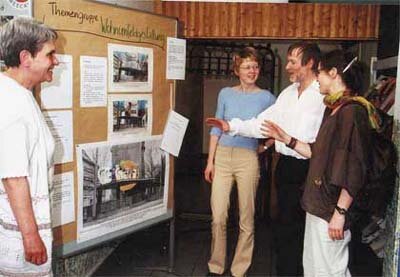 |
Residents in an issue-specific working group (Source: Büro Kaufmann, Leipzig) |
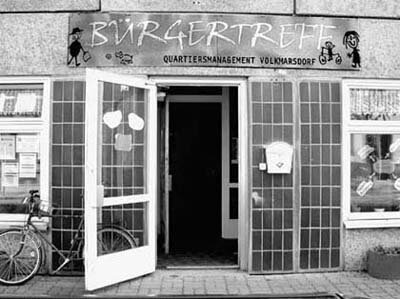 |
"Citizens' Centre" in Volkmansdorf (Source: doppelspitze, Leipzig) |
The activation work of the Volksmarsdorf neighbourhood management was supported in 2001 by a fund on hand to the amount of DM 30,000.
Public relations in East Leipzig relating to the model area covers a broad spectrum. The colour brochure "Socially Integrative City. East Leipzig: 'Let's get started!' has been published by the Leipzig municipality as documentation for the starter conference on the "Socially Integrative City" programme. Attention is drawn to meetings of the "East Leipzig Forum" not only by letters of invitation but also by colour flyers, postcards, and posters. The "Intercultural Contact Bureau" brings out the district magazine "Stadteilmagazin Leipziger Osten" in collaboration with the district management and other actors. It reports on forum meetings; gives the addresses of institutions and organisation in the area, provides an events calendar advertising advisory, recreational, and cultural facilities and events. The Volksmarsdorf neighbourhood management puts out a circular that is distributed to all households in the suburb, providing information about the progress of projects and about events in the "Citizens' Centre." Since January 2001 an Internet site, www.volkmarsdorf.de, also developed and maintained by the Volksmarsdorf neighbourhood management, has been informing residents about current developments in the area, recreational amenities, and the local housing market. Another Internet site for the entire model area is in preparation: www.leipziger-osten.de. Since the beginning of 2002, a municipal official has been made explicitly responsible for public relations in and for East Leipzig.
7. |
Conclusion: Integrated District Renewal in East Leipzig - The Foundations have been Laid
|
In implementing the "Socially Integrative City" programme, a wide-ranging project landscape has been developed for East Leipzig within a short space of time, which takes account of integrative district development in all important areas of action. However, "two speeds" are apparent: while the public authorities had already developed "core projects" in the run-up to programme implementation, bottom-up project development is only gradually getting under way. In the view of the local programme support team, care must be taken not to consolidate this imbalance by taking the timing and output notions of the authorities as the yardstick: to some extent they are determined by support rationales. After all, project development is intended to help establish self-sufficient structures in the model area.
In addition, the local programme support team believes that the integrated action plan for implementing the "Socially Integrative City" programme should be strengthened and more sharply distinguished from other plans with more of an urban development bias, and that it should be adopted by the city council to enable projects and measures as well as organisational and management units to obtain the necessary backing from the political and administrative authorities.
With the start of programme implementation, the Leipzig municipality created an organisational and management structure that encompassed all the relevant levels - administrative, intermediary, neighbourhood. At the neighbourhood level, however, only one "genuine" neighbourhood management is so far in place. If no further local neighbourhood managements are set up, the neighbourhood level and "activation of the neighbourhood population," a central issue for the "Socially Integrative City" programme, risk coming too short - both in general terms and in comparison with neighbourhood management organisation at the administrative and intermediary levels ("District Management" Forum).
East Leipzig residents show comparatively little personal initiative and organisation in their neighbourhoods. For this reason a range of largely project-oriented participation modes and activation techniques have been deployed, especially by the Volksmarsdorf neighbourhood management. However, the local programme support team considers expansion in non-project-specific and/or outreach work is needed to boost local resident activation.
Im Auftrag des BMVBS vertreten durch das BBR. Zuletzt geändert am 25.05.2005
